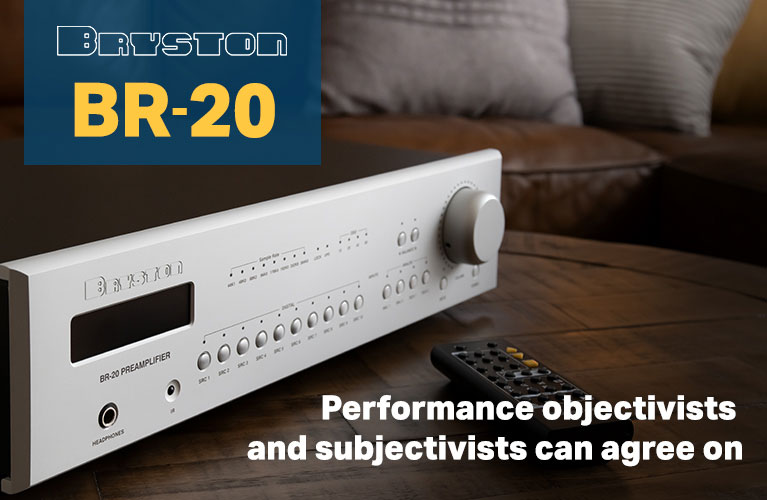Note: for the full suite of measurements from the SoundStage! Audio-Electronics Lab, click this link.
 Since 2009, miniDSP has developed a plethora of audio products relating to its namesake technology. The company’s current offerings include the UMIK line of measurement microphones, digital room correction systems, active crossovers, and many other DSP platforms for audio applications. Hong Kong–based miniDSP’s products are relatively inexpensive and are known for their excellent value. The subject of this review, the SHD Power, is the company’s most expensive product at $1549 (all prices in USD), but it is the least-expensive streaming integrated amplifier-DAC I know of that incorporates Dirac Live room correction.
Since 2009, miniDSP has developed a plethora of audio products relating to its namesake technology. The company’s current offerings include the UMIK line of measurement microphones, digital room correction systems, active crossovers, and many other DSP platforms for audio applications. Hong Kong–based miniDSP’s products are relatively inexpensive and are known for their excellent value. The subject of this review, the SHD Power, is the company’s most expensive product at $1549 (all prices in USD), but it is the least-expensive streaming integrated amplifier-DAC I know of that incorporates Dirac Live room correction.
A USB calibration microphone, the UMIK‑1, is included, but the upgraded UMIK‑2 mike can be selected instead for an additional $145. A small microphone tripod can be added for $15. Along with the SHD Power, the SHD line of products includes the SHD ($1299) and SHD Studio ($949) audio processors—the former features both analog and digital inputs and outputs, while the latter only has digital connectivity.
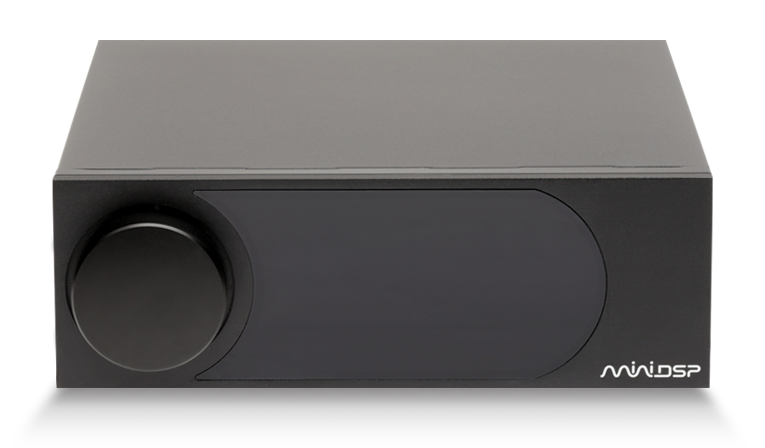
I have long been a fan of integrated amplifier-DACs for their convenience. More recently, with the advent of room correction, integrated amplifiers have become all the more appealing. Intrigued by the SHD Power, I requested a review sample from miniDSP, which kindly obliged.
Deceptively plain
The SHD Power is decked out in matte black, except for an elegant clear insert over the display screen. An array of small square holes in each side panel allows for ample ventilation. The unit is boxy and compact, measuring 2.75″H × 8.5″W × 8.9″D, and feels unexpectedly solid. The miniDSP logo graces the front panel at the lower right, complementing what I thought was an attractive, tidily professional look.
The large black knob on the left of the front panel feels reassuringly firm—an unexpected touch for a product at this price point. Functions are selected by pressing the knob, and adjusted by turning it. A large, centrally located monochrome OLED panel takes up much of the rest of the space, displaying volume level, input type, the preset selected, mute status, and whether Dirac Live is engaged. Despite the generous size of the screen, it was a little difficult to make out the displayed information from my sitting position. Thankfully, while carrying out any adjustment, the entire display changes to indicate the status of the function being adjusted—volume level, input selected, etc.—in large characters.
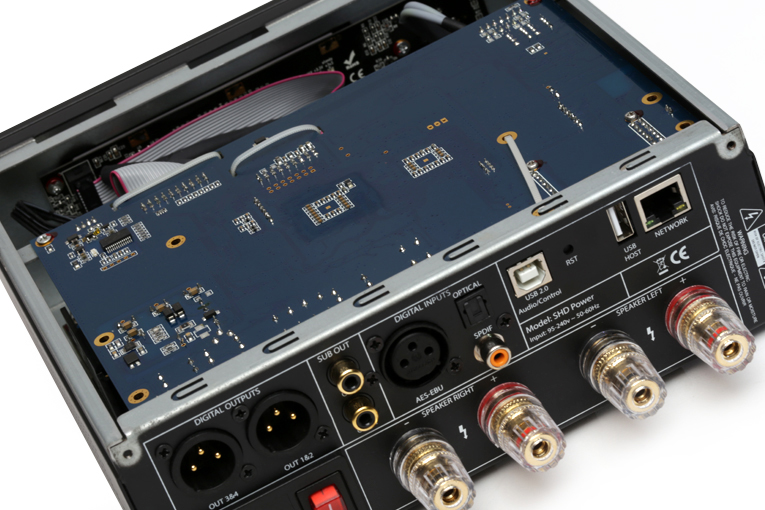
The back panel is quite crowded, and includes a chunky, solid set of speaker binding posts. Digital inputs consist of S/PDIF optical (TosLink) and coaxial (RCA), AES/EBU balanced (Neutrik XLR), and USB Type‑B connections. Two single-ended RCA analog outputs are provided for subwoofers. There are also dual two-channel digital outputs over AES/EBU (XLR). This means that the SHD Power can be utilized as a standalone two-channel in/four-channel out digital processor with full bass management. A USB Type‑A connector for attaching a Wi-Fi antenna or a local storage drive is situated next to an ethernet port. A power switch and a replaceable fuse are found next to the IEC power inlet.
The remote is small and light but has relatively large buttons; it’s of acceptable quality for a budget component. In addition to the typical navigation, volume, and mute controls, it allows direct access to presets, selection of input source, and engagement/disengagement of Dirac Live.
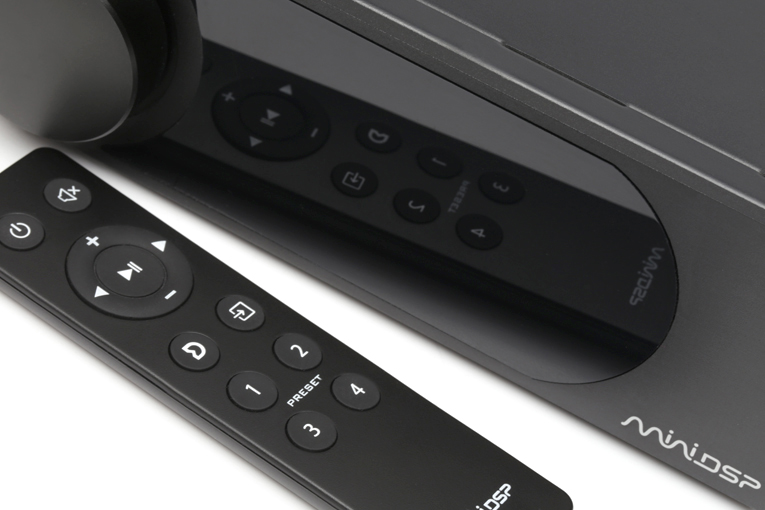
Although lacking analog inputs, Chromecast Built-in, Apple AirPlay, and a headphone output, the SHD Power includes features not normally found in a budget integrated amplifier-DAC: Roon Ready network streaming capability, parametric equalization, Dirac Live room correction, and adjustable high-pass/low-pass crossover filters. The SHD Power also runs the open-source Volumio music player, which is accessed through a web-based interface and supports Tidal, Qobuz, HighResAudio, Spotify (via a plugin), and internet radio. Considering its reasonable price, the SHD Power is remarkably fully featured.
The full-frequency Dirac Live room correction software runs on a 32‑bit, floating-point 450MHz Analog Devices SHARC DSP. Internal processing is specified at 32‑bit/96kHz, but the DSP will accept sample rates up to 192kHz. The SHD Power also features a Texas Instruments PCM1795 DAC chipset for its analog subwoofer outputs, and a quad-core ARM processor powers the Roon and Volumio streaming capabilities. The 120Wpc of amplification (into 8 or 4 ohms) is based on the Texas Instruments TPA3255 class‑D chipset. Signal-to-noise ratio is >110dB (at 1kHz, A‑weighted, 120W into 8 ohms). Four presets are available for onboard storage of configuration sets, which can include parametric EQ settings, crossover adjustments, and Dirac Live calibrations.
Setup and configuration
The miniDSP SHD Power can be used as a conventional integrated amplifier. I tried that with different digital sources: my LG OLED television, via the optical TosLink connection; an Intel NUC computer, via the USB-A port; and a hard drive loaded with music files attached to the USB-A input. For most of my listening, however, I used the SHD Power as a Roon endpoint, streaming over my home network via ethernet or Wi-Fi. I confirmed the functionality of the Volumio music player with Qobuz—it appears to be a fully featured streaming platform (you can read more about it in Gordon Brockhouse’s August 2020 review of the Volumio Primo streaming DAC).
Setting up the SHD Power was not particularly intuitive: specific steps had to be followed in the proper order to connect the unit to my network and begin streaming music, and I had to consult the user manual. In order to access the web-based Volumio interface, I first had to use Windows Connection Manager to connect to the miniDSP SHD hotspot. This opened a setup wizard that allowed me to access the SHD Power’s network settings and then to find and connect to my Wi-Fi network. Only then was I able to open the Volumio music player web page.
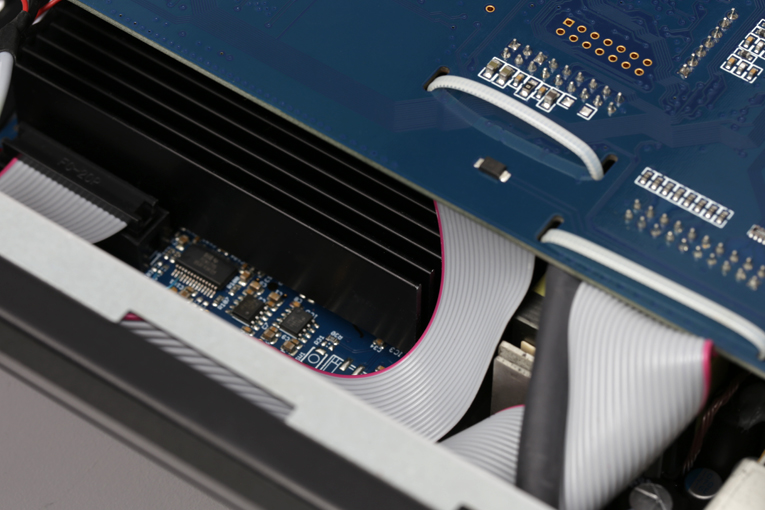
Purchasers can download miniDSP’s SHD Plugin configuration software from the company’s website. This enables configuration of the SHD Series processor from a PC or a Mac. For example, SHD Plugin allows the setting of time delays for display dim/sleep, choosing which input sources are active, specifying speaker impedance (which activates over-current protection when 4 ohms is selected), and routing the two input channels (labeled Dirac 1 and 2) to the four outputs (labeled Outputs 1 through 4), as well as setting each channel’s gain, parametric EQ, and crossovers. Outputs 1 and 2 are assigned to the speaker outputs and Outputs 3 and 4 to the line-level subwoofer outputs. The first digital output is assigned Outputs 1 and 2, while the second digital output is assigned Outputs 3 and 4.
I did not use any of the advanced features of SHD Plugin, but I did use it to set up Dirac Live. Unlike with most systems I’ve used, the Dirac Live application did not recognize the SHD processor when launched directly on my MacBook Air, even though the SHD Power was connected to the same network. Dirac Live must be launched from within SHD Plugin, and the SHD Power must be connected to the computer by USB to be recognized by the software. Only then was I able to set up room correction. I used the default Dirac correction curve without any additional adjustments or equalization, assigning settings for my main and alternate systems, with and without subwoofers, to different presets.
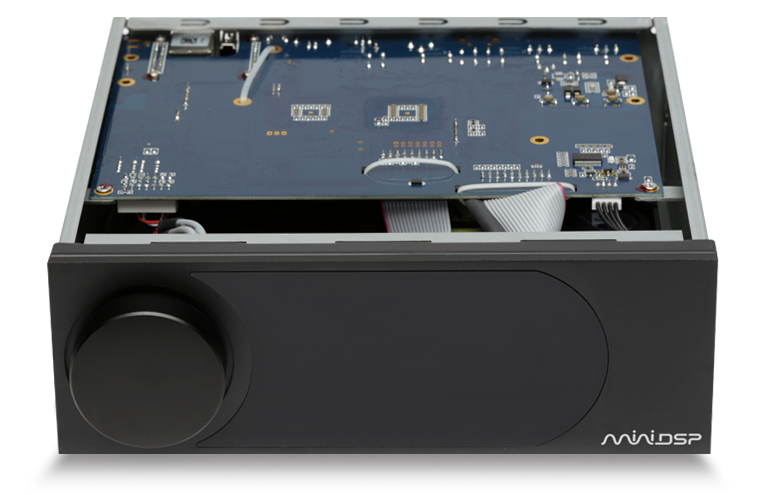
One thing not mentioned in the manual is that the System Version can only be updated online, which was required to enable Roon Ready capability. Once updated, everything worked as expected: I was able to play high-resolution FLAC and DSF files from a connected USB drive and to stream from Qobuz. I was also able to stream via UPnP with Mconnect Player Lite on an iPhone 6s. Although I preferred Roon, Volumio is a very usable player.
My main system consists of an Intel NUC computer, a pair of MartinLogan Masterpiece Classic ESL 9 speakers, and two JL Audio E‑Sub e112 powered subwoofers. The audio cables are a combination of Clarus, AudioQuest, and Analysis Plus, and the power cables and power conditioning are by ESP, Zero Surge, and Blue Circle Audio. My family-room system comprises a pair of PSB Alpha T20 speakers, an Nvidia Shield TV Pro streaming media player, an Arris cable box, an LG C9 OLED television (connected to the miniDSP via TosLink), and a MacBook Air laptop computer.
Sound and room correction
The PSB Alpha T20s are relatively small floorstanders that are not difficult to drive, and the SHD Power handled them with ease. It provided excellent control with movies and television shows, even when playing back lossy Dolby Digital–encoded soundtracks. This was particularly apparent when Dirac Live was engaged. There isn’t a great deal of music or Foley effects on The Simpsons, but Moe Szyslak’s lines were made noticeably more intelligible with Dirac. Moe’s voice is quite nasal, but Dirac made it much clearer (though still gravelly); his pronounced New York accent became much more apparent. Musical items from current streaming shows, such as the catchy theme from the opening credits of Peacemaker or background music on The Righteous Gemstones, were banging. The SHD Power also allowed the more complex sound design of season 4 of The Marvelous Mrs. Maisel to shine through. I could easily track the sound of Midge Maisel’s stylish 1960s footwear as she walked across a room, and I could perfectly place the musicians at Shy Baldwin’s wedding, imaged in the soundstage to mirror their placement on the ballroom stage. And as the camera panned around the ballroom, the sound of applause and background conversations tracked the onscreen action precisely.
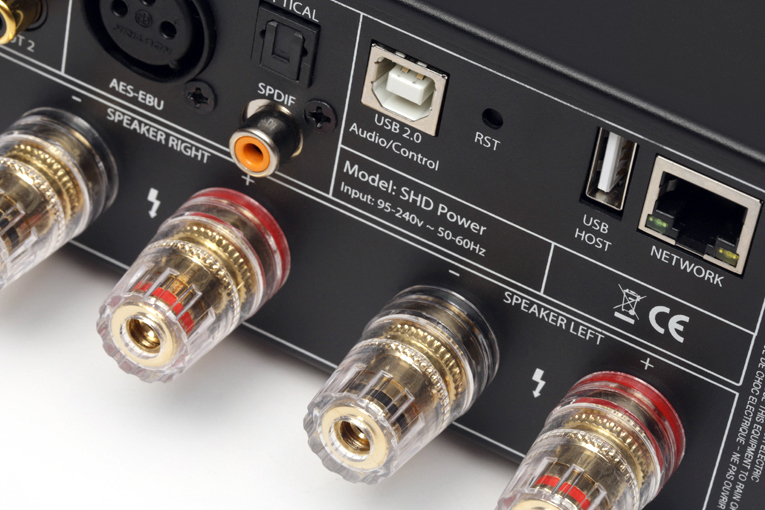
Not only did the SHD Power’s ample power and Dirac room correction sharpen speech and image audio from TV shows and movies superbly, but it also rendered music with clarity and coherence—and to an astounding degree for such a modest system. Brandi Carlile’s voice on the stunning In These Silent Days (24-bit/96kHz FLAC, Elektra Records / Low Country Sound / Qobuz) was planted solidly between the speakers, her instrumental accompaniment imaged precisely around her. There was such a remarkable presence to her vocals throughout the album that it was difficult not to continue listening to track after track. However, while clear in the midrange, Carlile’s voice had some sibilance, and I wished it had a touch more warmth and body.
Bach’s Toccata and Fugue in D Minor, BWV 565, from Olivier Latry’s Bach to the Future (24/96 FLAC, La Dolce Volta / Qobuz), had incredibly deep and tight bass. I kept waiting for the speakers’ woofers or cabinets to start rattling or for the room to become overloaded, but that never happened. The bass remained controlled and balanced at all times. Switching to something a bit more complex, Billy Idol’s vocals in “Dancing with Myself (RAC Remix),” from Vital Idol: Revitalized (16/44.1 FLAC, Capitol Records / Qobuz), were quite forward but hung tantalizingly in front of me, between the speakers, with amazing palpability. Again, there was a touch more sibilance than I am used to hearing with this track, but I was more than willing to overlook this, given the outstanding imaging and taut bass.
When I moved the SHD Power into my main system, I was impressed by how well this little $1549 amp could power my ESL 9s—there was enough power to drive the hybrid-electrostatic speakers at room-filling levels. Without room correction, the sound was a little unfocused and uninvolving, but once I engaged Dirac Live, the soundstage snapped into focus. “Superman March,” from John Williams: The Berlin Concert (24/192 FLAC, Deutsche Grammophon / Qobuz), had a grand sense of scale; the delineation of instruments was excellent, even though they were all imaged on roughly the same plane, set back slightly behind the speakers. The percussion was well placed—the bass drum solidly center stage; the snare slightly off to the left—but I would have liked a little more depth overall.
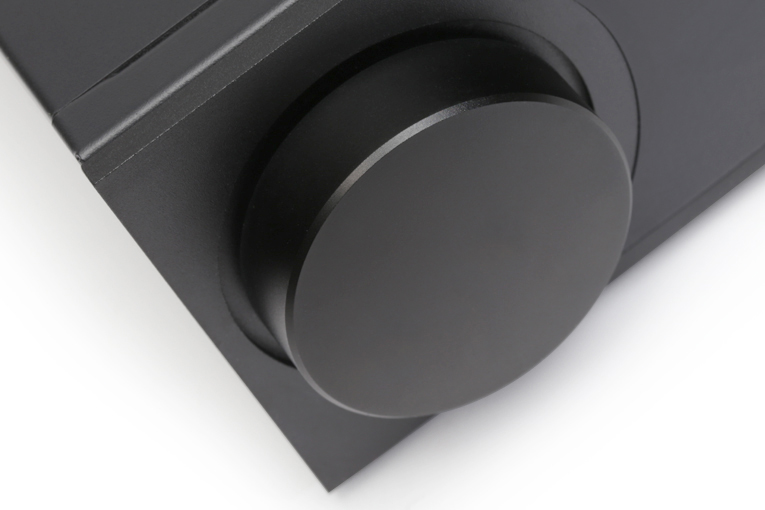
The SHD Power sounded good with the ESL 9s, but adding my dual JL Audio subwoofers allowed the system to play more loudly and with greater headroom. This opened up the sound, creating a soundstage with greater width and depth. The various sections of the orchestra on “Superman March” were now imaged at slightly different depths, with the percussion at the back and the strings and wind instruments more forward. The kickdrum in “Right On Time,” the opening track on Carlile’s In These Silent Days, had more heft now, as did the lower registers of the piano.
Comparison
Not surprisingly, the miniDSP SHD Power could not compete with the much more expensive integrated amplifier-DACs with room correction that have recently come through my system, such as the NAD Masters M33 ($5499), Lyngdorf Audio TDAI‑3400 (starting at $6499), Anthem STR Integrated ($4999.99), and Arcam SA30 ($3300). But it made for an interesting comparison with the Lyngdorf Audio TDAI‑1120 ($2199).
Both the TDAI‑1120 and SHD Power feature class‑D amplifier topologies and room correction systems, and both sound wonderful with the PSB Alpha T20s—but in different ways. The Lyngdorf’s 60Wpc Equibit amplification was sweeter and more relaxed, while the miniDSP was tighter and more controlled, with stellar imaging. The “Edge of Midnight (Midnight Sky Remix),” from Miley Cyrus’s Plastic Hearts (24/44.1 FLAC, RCA Records Label / Qobuz), can sound a little diffuse, but the miniDSP gave better definition and articulation to the drums and electric bass. In contrast, the Lyngdorf tamed some of the abundant sibilants better, but that tended to mask some of the snarly contempt in Cyrus’s gravelly vocals. I would be hard-pressed to pick between these two amps in my family-room system.
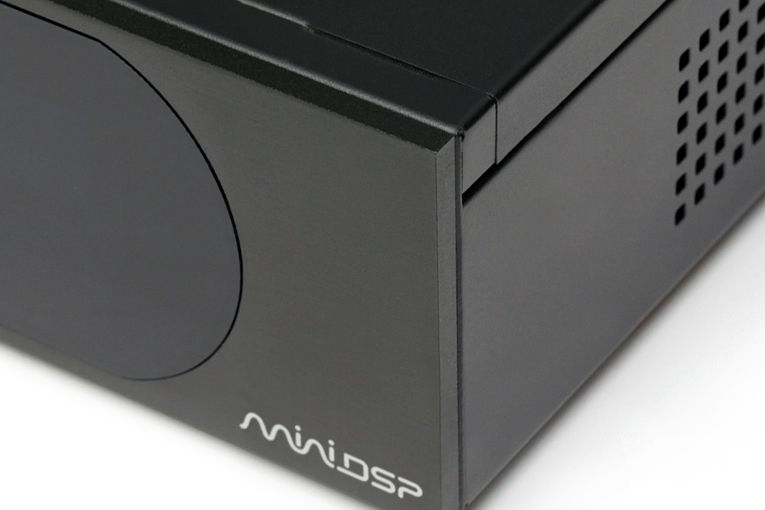
Those differences became more apparent when driving the MartinLogan loudspeakers in my main system. The miniDSP was able to drive the hybrid-electrostatic ESL 9s with greater ease than the Lyngdorf, which struggled to unravel complex passages at high levels. Playing Sting’s My Songs: Special Edition (24/44.1 FLAC, A&M Records / Interscope Records / Qobuz), “Desert Rose” had greater depth and width of soundstage and well-defined imaging of the vocals and instruments with the miniDSP. While the Lyngdorf’s presentation was a little vague, it still had that invitingly smooth Equibit sound. Adding the two JLA E‑Sub e112 subwoofers to the mix tipped the scales in favor of the Lyngdorf. While both amps benefited from the addition of the subs, the effect on the Lyngdorf, now freed of the requirement of amplifying the lower frequencies, was truly transformative. The mids and highs remained smooth and inviting but were more sharply focused. The synthesizer sounds and vocalizations of Sting and Cheb Mami swirled effortlessly between the speakers with wonderful openness, warmth, and coherence. The miniDSP too sounded better with the subs, but the soundstage did not open up as fully—the voices and instruments remaining more closely grouped together, and the sound remaining a little cool and not as lush.
Unmatched value
With Dirac Live room correction, Roon Ready certification, Volumio music player, and many other useful functions, the miniDSP SHD Power is priced much lower than any other integrated amplifier-DAC with similar features that I know of. When used with high-quality speakers of commensurate price, it can provide performance far beyond what you would expect from such a budget-oriented system. For anyone desiring a fully featured, digital integrated amplifier-DAC at an entry-level price, the SHD Power would be a fine choice.
. . . Roger Kanno
rogerk@soundstagenetwork.com
Associated Equipment
- Speakers: MartinLogan Masterpiece Classic ESL 9, PSB Alpha T20.
- Subwoofers: JL Audio E‑Sub e112 (×2).
- Integrated amplifier: Lyngdorf Audio TDAI‑1120.
- Digital sources: Intel NUC computer running Windows 10, MacBook Air, Roon and Qobuz, AudioQuest JitterBug jitter reducer, Nvidia Shield TV Pro.
- Speaker cables: Clarus Aqua Mark II.
- USB link: AudioQuest Carbon.
- Power cords: Clarus Aqua.
- Power conditioners: Blue Circle Audio PLC Thingee FX‑2 with X0e low-frequency filter module, Zero Surge 1MOD15WI.
miniDSP SHD Power Integrated Amplifier-DAC
Price: $1549.
Warranty: One year, parts and labor.
miniDSP Ltd.
Unit 307, Kingsford Industrial Centre
13 Wang Hoi Road
Kowloon Bay
Hong Kong
Phone: +852 235 82066
Website: www.minidsp.com






















